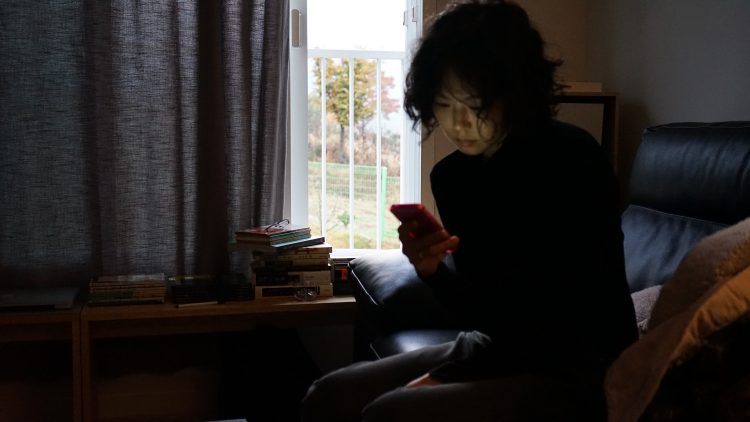Very little in Hong Sang-soo’s “The Woman Who Ran” plays as if it is a mystery to be solved. Instead, the brief wisp of a story – its running time is 77 minutes – at first, and even second, glance seems like the opposite of mysterious. Over the course of three days, Gam-hee (played with an air of restless casualness by Kim Min-hee) meets with three friends. Her husband is away on a business trip, and she is using the time away from him – the first time they have been apart in their five years of marriage – to enjoy an extended vacation of sorts. Little happens in the way of narrative plot-points. Instead, Hong structures the film as three series of conversations as the women ruminate on topics that seem more incidental than propulsive. And, yet, the unanswered question of the title persists. By the third time that Gam-hee glibly emphasises that this is the first time she and her husband have spent a day apart since their marriage, “The Woman Who Ran” seems to be building itself into an atypical kind of puzzle. Ostensibly, casual and straightforward but lingering on brief moments of unusualness.

The casual calmness of the film’s events seems at odds with the specificity of the title. It’s part of the charm of Hong’s work here, which puts the jagged overt looseness of the film in conversation with a tension that persists beneath. The opening, for example, informs this. We do not begin with Gam-hee, but instead with a group of trapped chickens in a coop. They belong to the neighbour of one of the first friends that she visits. It’s the first of two extended sequences with animals and there is a metaphor somewhere there about animals and humans, but Hong is slyly noncommittal about the what and the why in what is the funniest section of the film. Gamhee’s conversations with her friend Young-soon, and Young-soon’s roommate Young-ji, cover a range of topics – love, romance, men, vegetarianism – that become amusingly arch for the strange banality of their cadence. The three women are constantly speaking, and yet each sentence feels like it’s hiding another sentence and another thought.
Just when their conversations seem to be stalling, they are interrupted by a male neighbour. In the same way the film is structured around three conversations with women – the interruption of male figure recurs, throughout. This first interruption toes the line between ludicrous and hilarious. A newly moved-in neighbour arrives to request that Young-soon stop feeding the stray cats in the neighbourhood. His wife is afraid of them. Both parties are effortfully polite, even as the conversations grows more and more strained. Young-soon insists, cats are as valuable as neighbours. The man grows incredulous and then frustrated. As they drone on, the camera zooms in on one of the cats observing the conversation. What is he thinking? Who knows?
Odd moments like this one punctuate the film. In Gam-hee’s second visit, with Su-young – another friend – there is another charged hallway conversation. This time, though, instead of a stranger it is a meeting with a one-night stand who seems too invested in their brief encounter. Su-young grows more ambivalent, as her young lover grows more agitated. Gam-hee observes the encounter on the CCTV cameras. By that point in the film, the surveillant aspect of the city has already been commented on. So, by the time Gam-hee makes her third visit, where she runs into another friend while visiting an arthouse cinema, the question of watching versus being watched feels significant.
The third visit moves from off-kilter humour to something less careless. This friend, Woo-jin, was not an intended visit and as Gam-hee regurgitates strains of previous conversations, particularly her adamant confession that this is her first time away from her husband in five years, her entire repose feels like a performance. By this point, it feels as if days have passed since the first visit and as Woo-jin’s current husband emerges as a character of interest from Gam-hee’s own past it feels like Hong is playfully encouraging us to work the film, even if he seems ambivalent about finding any resolution.
By the time the final scene comes around, a nifty meta reference to Hong’s work, the film and the audience that offers no clarity at an explanation but instead teasingly leaves us with an ellipsis, we are left with questions. Who is the woman who ran? Is it Gam-hee? Running from something or towards? Hong offers no answers. It’s a mark of sharp focus that the deliberate opacity at the centre of “The Woman Who Ran” comes off as carelessly charming rather than frustrating or inscrutable. For aficionados of Hong’s style, the film might present a labyrinth of his familiar thesis and ideas but even those unfamiliar with Hong’s work can be charmed by the film’s easy whimsy. Min-hee layers her off-kilter performance with a tender sadness beneath, and her isolation – psychological but even physical – feels apropos for a film festival held virtually emphasising the aloneness of the experience. In “The Woman Who Ran,” life is winnowed down to a series or repetitious interactions. The idea does not feel unapt.
“The Woman Who Ran” screened in the Main Slate category of the New York Film Festival.




